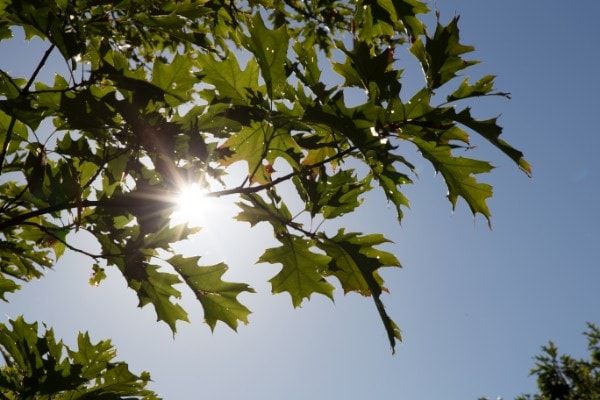13.1.1
Introduction to Photosynthesis
Importance of Photosynthesis
Importance of Photosynthesis
Photosynthesis is essential to all life on earth. Both plants and animals depend on the ability of this process to capture energy originating in outer space and convert it into chemical compounds.


Photoautotrophs
Photoautotrophs
- Plants, algae and a group of bacteria called cyanobacteria are the only organisms capable of performing photosynthesis.
- These organisms manufacture their own food using light energy and are therefore called photoautotrophs (self-feeders using light).
- Other organisms, like animals, fungi and most other bacteria are called heterotrophs (other feeders), as they rely on sugars produced by photosynthetic organisms for their energy.


Storing energy
Storing energy
- Photosynthesis is important not only for capturing sunlight's energy, but also for storing it in the carbon-carbon bonds of carbohydrate molecules.
- These carbohydrates are the energy source that heterotrophs use for synthesising ATP by respiration.
- Through a chain of energy transfers, photosynthesis powers 99% of Earth's ecosystems.
Equation for Photosynthesis
Equation for Photosynthesis
Photosynthesis is a multi-step process that requires sunlight, carbon dioxide (which is low in energy) and water as substrates. It produces simple carbohydrate molecules and oxygen as a byproduct.


Chemical equation
Chemical equation
- This basic equation is deceptively simple, as the process takes place in many steps involving intermediate reactants and products.


Photosynthesis and respiration
Photosynthesis and respiration
- You may also have noticed that the photosynthesis reaction is the reverse of the reaction for respiration.
- This makes sense, as respiration is about releasing energy, whereas photosynthesis is the process by which energy is captured and stored.
- You may also have noticed that the photosynthesis reaction is the reverse of the reaction for respiration.
Structure of the Leaf
Structure of the Leaf
In plants, photosynthesis generally takes place in the leaves, which consist of several layers of cells. Photosynthesis occurs in a middle layer called the mesophyll.


Stomata
Stomata
- The gas exchange of carbon dioxide and oxygen occurs through small, regulated openings in the underside of the leaf, called stomata.
- Stomata are also involved in water balance, with guard cells regulating the opening and closing of the stomata by swelling or shrinking in response to osmotic changes.


Chloroplasts
Chloroplasts
- In all autotrophic eukaryotes, photosynthesis takes place inside an organelle called a chloroplast.
- Chloroplasts have a double membrane envelope (comprising an outer and inner membrane) and contain chloroplast DNA.


Thylakoids
Thylakoids
- Within a chloroplast are stacked, disc-shaped structures called thylakoids.
- Embedded in the thylakoid membrane are:
- Chlorophyll, a pigment (light-absorbing molecule) responsible for the initial interaction between light and plant material.
- Proteins which make up the electron transport chain.
- Embedded in the thylakoid membrane are:
- A stack of thylakoids is called a granum and the liquid-filled space surrounding the granum is the stroma.
1Cell Structure
1.1Cell Structure
1.1.1Studying Cells - Microscopes
1.1.2Introduction to Eukaryotic & Prokaryotic Cells
1.1.3Ultrastructure of Eukaryotic Cells
1.1.4Ultrastructure of Eukaryotic Cells 2
1.1.5Ultrastructure of Eukaryotic Cells 3
1.1.6Prokaryotic Cells
1.1.7Viruses
1.1.8End of Topic Test - Cell Structure
1.1.9Exam-Style Question - Microscopes
1.1.10A-A* (AO2/3) - Cell Structure
2Biological Molecules
2.1Testing for Biological Modules
2.2Carbohydrates & Lipids
2.3Proteins
3Enzymes
4Cell Membranes & Transport
4.1Biological Membranes
5The Mitotic Cell Cycle
6Nucleic Acids & Protein Synthesis
6.1Nucleic Acids
7Transport in Plants
8Transport in Mammals
8.1Circulatory System
8.2Transport of Oxygen & Carbon Dioxide
9Gas Exchange
9.1Gas Exchange System
10Infectious Diseases
10.1Infectious Diseases
10.2Antibiotics
11Immunity
12Energy & Respiration (A2 Only)
13Photosynthesis (A2 Only)
14Homeostasis (A2 Only)
14.1Homeostasis
14.2The Kidney
14.3Cell Signalling
14.4Blood Glucose Concentration
14.5Homeostasis in Plants
15Control & Coordination (A2 Only)
15.1Control & Coordination in Mammals
15.1.1Neurones
15.1.2Receptors
15.1.3Taste
15.1.4Reflexes
15.1.5Action Potentials
15.1.6Saltatory Conduction
15.1.7Synapses
15.1.8Cholinergic Synnapses
15.1.9Neuromuscular Junction
15.1.10Skeletal Muscle
15.1.11Sliding Filament Theory Contraction
15.1.12Sliding Filament Theory Contraction 2
15.1.13Menstruation
15.1.14Contraceptive Pill
15.2Control & Co-Ordination in Plants
16Inherited Change (A2 Only)
16.1Passage of Information to Offspring
16.2Genes & Phenotype
17Selection & Evolution (A2 Only)
17.2Natural & Artificial Selection
18Classification & Conservation (A2 Only)
18.1Biodiversity
18.2Classification
19Genetic Technology (A2 Only)
19.1Manipulating Genomes
19.2Genetic Technology Applied to Medicine
19.3Genetically Modified Organisms in Agriculture
Jump to other topics
1Cell Structure
1.1Cell Structure
1.1.1Studying Cells - Microscopes
1.1.2Introduction to Eukaryotic & Prokaryotic Cells
1.1.3Ultrastructure of Eukaryotic Cells
1.1.4Ultrastructure of Eukaryotic Cells 2
1.1.5Ultrastructure of Eukaryotic Cells 3
1.1.6Prokaryotic Cells
1.1.7Viruses
1.1.8End of Topic Test - Cell Structure
1.1.9Exam-Style Question - Microscopes
1.1.10A-A* (AO2/3) - Cell Structure
2Biological Molecules
2.1Testing for Biological Modules
2.2Carbohydrates & Lipids
2.3Proteins
3Enzymes
4Cell Membranes & Transport
4.1Biological Membranes
5The Mitotic Cell Cycle
6Nucleic Acids & Protein Synthesis
6.1Nucleic Acids
7Transport in Plants
8Transport in Mammals
8.1Circulatory System
8.2Transport of Oxygen & Carbon Dioxide
9Gas Exchange
9.1Gas Exchange System
10Infectious Diseases
10.1Infectious Diseases
10.2Antibiotics
11Immunity
12Energy & Respiration (A2 Only)
13Photosynthesis (A2 Only)
14Homeostasis (A2 Only)
14.1Homeostasis
14.2The Kidney
14.3Cell Signalling
14.4Blood Glucose Concentration
14.5Homeostasis in Plants
15Control & Coordination (A2 Only)
15.1Control & Coordination in Mammals
15.1.1Neurones
15.1.2Receptors
15.1.3Taste
15.1.4Reflexes
15.1.5Action Potentials
15.1.6Saltatory Conduction
15.1.7Synapses
15.1.8Cholinergic Synnapses
15.1.9Neuromuscular Junction
15.1.10Skeletal Muscle
15.1.11Sliding Filament Theory Contraction
15.1.12Sliding Filament Theory Contraction 2
15.1.13Menstruation
15.1.14Contraceptive Pill
15.2Control & Co-Ordination in Plants
16Inherited Change (A2 Only)
16.1Passage of Information to Offspring
16.2Genes & Phenotype
17Selection & Evolution (A2 Only)
17.2Natural & Artificial Selection
18Classification & Conservation (A2 Only)
18.1Biodiversity
18.2Classification
19Genetic Technology (A2 Only)
19.1Manipulating Genomes
19.2Genetic Technology Applied to Medicine
19.3Genetically Modified Organisms in Agriculture
Unlock your full potential with Seneca Premium
Unlimited access to 10,000+ open-ended exam questions
Mini-mock exams based on your study history
Unlock 800+ premium courses & e-books